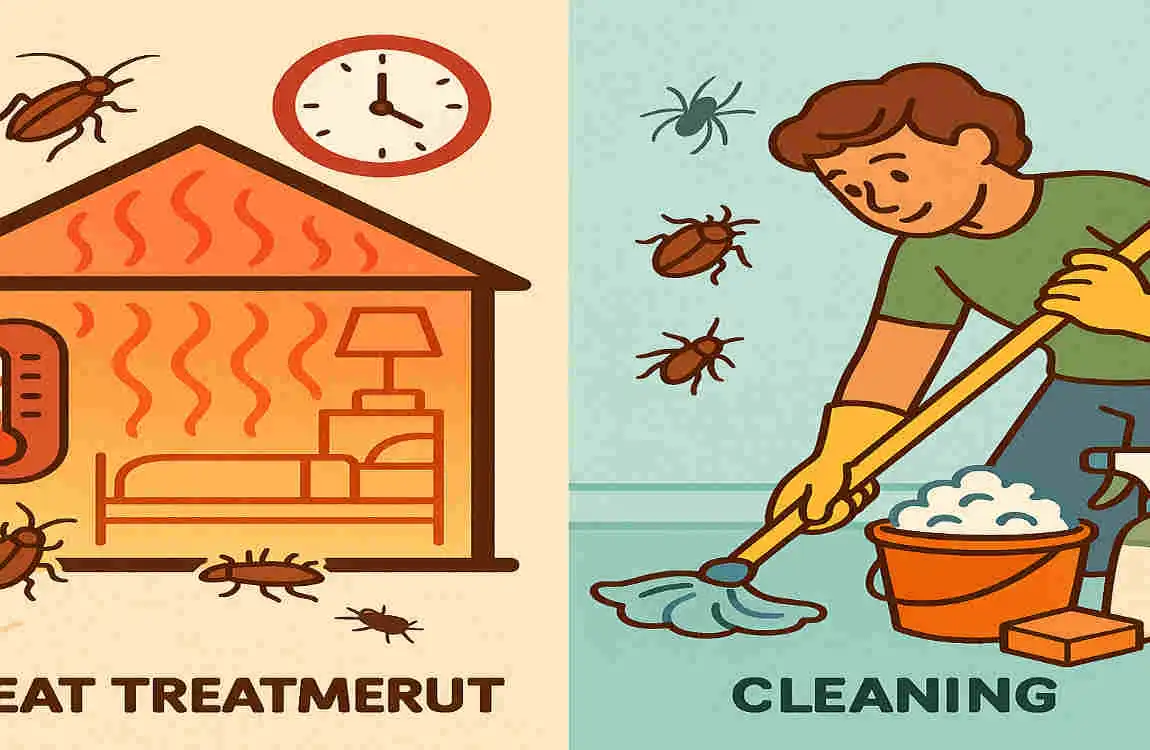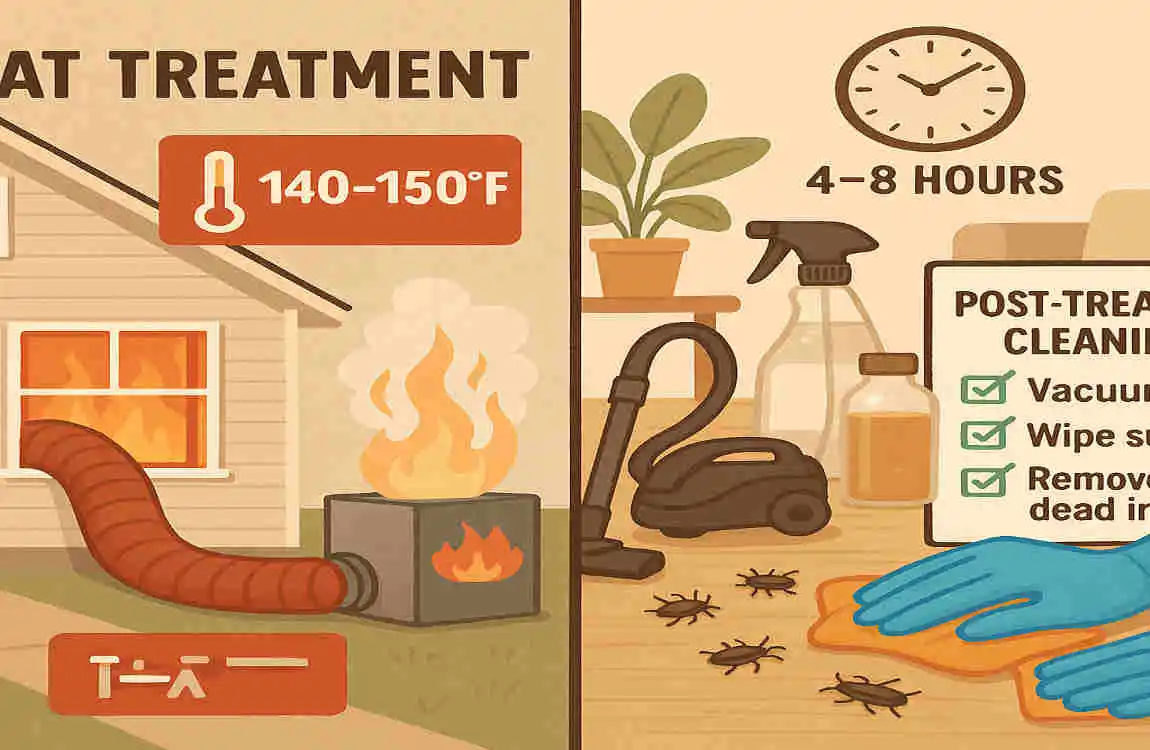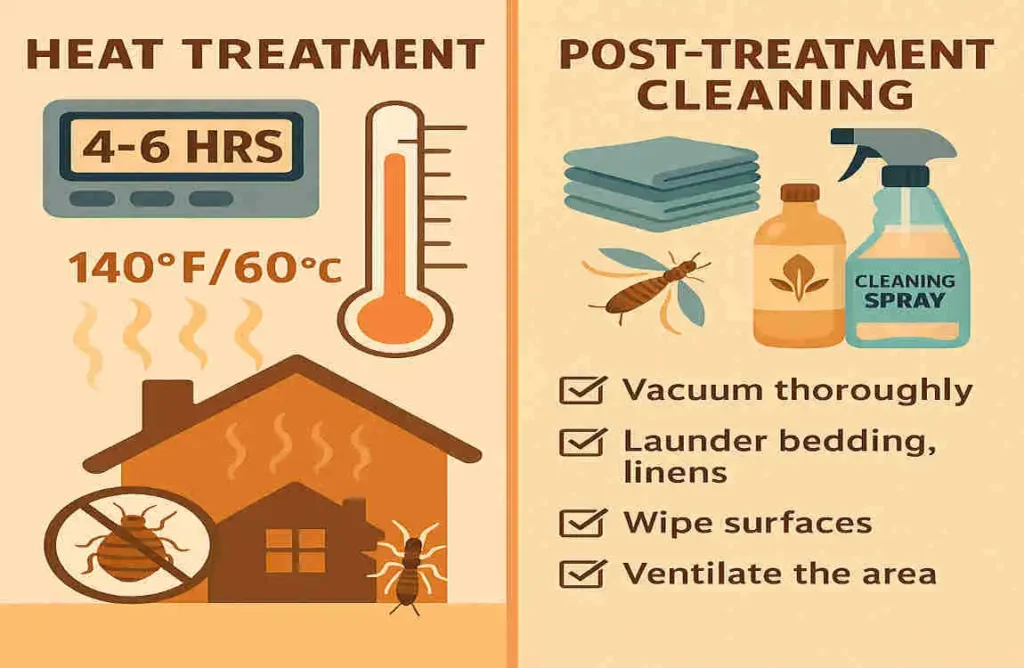Dealing with pests in your home can be a real headache. From bed bugs to termites and cockroaches, these unwelcome guests can make your life miserable. But don’t worry —there’s a solution gaining popularity: heat treatment.
What Is Heating for Insect Control?

The Basics of Heat Treatment
Heat treatment is a non-chemical pest control approach that raises the temperature in your home cleaning to levels lethal to insects. By using specialized equipment, pest control professionals can heat your entire house, ensuring that even the most stubborn pests are eliminated.
Common Targets of Heat Treatment
Heat treatment is particularly effective against a variety of common household pests, including:
- Bed bugs
- Termites
- Cockroaches
- Fleas
- Mites
These insects struggle to survive at high temperatures, making heat treatment an effective way to control infestations.
How Heating Eliminates Insects
The key to heat treatment’s success lies in its ability to raise the temperature of your home to a level that’s deadly to insects. Most pests cannot survive when exposed to temperatures above 120°F (49°C) for an extended period. By maintaining these high temperatures throughout your home, heat treatment ensures that all stages of the insect life cycle—from eggs to adults—are effectively eliminated.
Benefits of Heating Compared to Chemical Treatments
While chemical treatments have their place in pest control, heat treatment offers several advantages:
- No harmful chemicals: Heat treatment is a non-toxic approach, making it safer for you, your family, and the environment.
- Whole-house treatment: Unlike chemical treatments that may require multiple applications in different areas, heat treatment can treat your entire home in a single application.
- No resistance: Insects cannot develop resistance to heat, ensuring that this method remains effective over time.
- Quick results: Heat treatment can often eliminate an infestation in a single session, saving you time and hassle.
How Long Does Heating for Insect Control Take?
Typical Duration of a Heating Treatment Process
On average, a heating treatment for insect control takes between 4 and 8 hours to complete. However, the exact duration can vary depending on several factors.
Factors Influencing Duration
Several factors can influence the duration of a heating treatment:
- Size of the house: Larger homes may take longer to heat evenly and maintain the desired temperature.
- Severity of infestation: Heavier infestations may require longer exposure times to ensure all pests are eliminated.
- Equipment and technology used: Advanced heating equipment can heat your home more quickly and efficiently.
- Weather and insulation: The outdoor temperature and your home’s insulation can affect how long it takes to reach and maintain the target temperature.
What Happens During Heating: A Step-by-Step Overview
During a heating treatment, the process typically unfolds as follows:
- Preparation: Your pest control professional will prepare your home by sealing off any areas that don’t need treatment and setting up the heating equipment.
- Heating: The heating equipment is turned on, and the temperature in your home is gradually raised to the target level.
- Maintenance: Once the target temperature is reached, it is maintained for several hours to ensure that all pests are eliminated.
- Cooling: After the treatment is complete, the heating equipment is turned off, and your home cools to a comfortable temperature.
Safety Precautions During the Process
Your safety is a top priority during a heating treatment. Pest control professionals take several precautions to ensure that the process is carried out safely:
- Monitoring: Temperature sensors are placed throughout your home to monitor the heating process and ensure that the target temperature is maintained.
- Ventilation: After treatment, your home is thoroughly ventilated to remove residual heat and ensure a comfortable environment.
- Protecting sensitive items: Your pest control professional will take steps to protect heat-sensitive items, such as electronics and certain types of furniture, during the treatment.
Signs That Heating Treatment Is Working and When It’s Complete
During and after a heating treatment, you may notice several signs that the process is working:
- Increased insect activity: As the temperature rises, you may see an increase in insect activity as they try to escape the heat.
- Dead insects: After the treatment is complete, you may find dead insects around your home, indicating that the heat was successful in eliminating them.
- No further signs of infestation: In the days and weeks following the treatment, you should notice a significant reduction in signs of infestation, such as bites, stains, or sightings of live insects.
Your pest control professional will monitor the treatment process and let you know when it’s complete and safe to return to your home.
Preparing Your Home for Heat Treatment
Essential Steps Before Heating Treatment
To ensure the success of your heating treatment, it’s important to take a few essential steps to prepare your home:
- Declutter: Remove any unnecessary items from your home to make it easier for the heat to penetrate all areas.
- Launder fabrics: Wash all bedding, curtains, and clothing in hot water to kill any insects that may be hiding in them.
- Vacuum: Thoroughly vacuum your home, focusing on cracks and crevices where insects may be hiding.
- Seal food: Seal all food items to prevent contamination during heating.
Cleaning Tips to Improve Effectiveness
Proper cleaning before a heating treatment can significantly improve its effectiveness. Here are some tips to keep in mind:
- Remove clutter: Clutter can provide hiding places for insects, making it harder for the heat to reach them. Take the time to declutter your home before the treatment.
- Wash fabrics: Insects can hide in bedding, curtains, and clothing. Wash these items in hot water to eliminate any hidden pests.
- Vacuum thoroughly: Vacuuming can help remove insects and their eggs from your home. Be sure to vacuum all areas, including cracks and crevices.
Protecting Heat-Sensitive Items
While heat treatment is generally safe for most household items, some heat-sensitive items may require special protection. Your pest control professional can provide guidance on how to protect these items, which may include:
- Electronics: Unplug all electronics and remove any batteries to prevent damage from the heat.
- Plants: Move any potted plants outside or to a cool, shaded area during the treatment.
- Certain types of furniture: Wicker or rattan furniture may be sensitive to heat. Your pest control professional can advise you on how to protect these items.
Communicating with Pest Control Professionals
Open communication with your pest control professional is key to ensuring a successful heating treatment. Be sure to:
- Ask questions: Don’t hesitate to ask your pest control professional any questions you may have about the process.
- Provide information: Let your pest control professional know about any areas of your home that are heavily infested or any special concerns you may have.
- Follow instructions: Your pest control professional will provide specific instructions on preparing your home for the treatment. Be sure to follow these instructions carefully to ensure the best possible results.
Effective Cleaning Tips After Heating for Insect Control

Why Cleaning After Heat Treatment Is Important
Cleaning after a heating treatment is crucial for maintaining the results and preventing re-infestation. While the heat treatment itself is highly effective at eliminating insects, some eggs or insects may have been missed. Thorough cleaning can help remove any remaining pests and their eggs, ensuring that your home remains pest-free.
Detailed Cleaning Checklist
After your heating treatment, be sure to follow this detailed cleaning checklist to maintain the results:
- Vacuum thoroughly: Vacuum all areas of your home, paying special attention to cracks and crevices where insects may hide.
- Wash bedding, curtains, and clothing: Launder all bedding, curtains, and clothing in hot water to eliminate any remaining insects or eggs.
- Clean cracks and crevices: Use a brush or a crevice tool to remove debris and dust where insects may be hiding.
- Dispose of vacuum bags or debris safely: Seal and dispose of vacuum bags or debris in an outdoor trash can to prevent re-infestation.
Tips on Avoiding Re-infestation Through Routine Cleaning
To prevent re-infestation, it’s essential to establish a routine cleaning schedule. Here are some tips to keep in mind:
- Vacuum regularly: Vacuum your home at least once a week, focusing on areas where insects may hide.
- Wash bedding and curtains regularly: Wash bedding and curtains in hot water at least once a month to eliminate any insects or eggs.
- Declutter: Keep your home free of clutter to reduce hiding places for insects.
- Seal entry points: Seal any cracks or gaps around doors, windows, and utility lines to prevent insects from entering your home.
Using Insect-Repellent Cleaning Products
In addition to regular cleaning, you can use insect-repellent cleaning products to help keep pests at bay. These products are available in natural or chemical formulations, depending on your preferences.
- Natural insect-repellent cleaning products: Products containing essential oils like lavender or eucalyptus can help repel insects without harsh chemicals.
- Chemical insect-repellent cleaning products: Chemical products, such as those containing pyrethroids or permethrin, can be effective at repelling and killing insects. However, be sure to use these products according to the manufacturer’s instructions and take appropriate safety precautions.
Cleaning Product Type Pros Cons
Natural – Safe for humans and pets
– Environmentally friendly – May not be as effective as chemical products
– Can be more expensive
Chemical – Highly effective at repelling and killing insects
– Often less expensive than natural products – May contain harsh chemicals
– Can be harmful to humans and pets if not used properly
Common Mistakes to Avoid When Heating for Insect Control and Cleaning
Overheating Risks and Their Impact on Home Structure
While heat treatment is generally safe for most homes, overheating can pose risks to your home’s structure. Overheating can cause:
- Damage to walls and ceilings: Excessive heat can cause paint to peel, wallpaper to loosen, and drywall to crack.
- Warping of wood: High temperatures can cause wood to expand and contract, leading to warping and cracking.
- Melting of plastics: Plastics, such as those found in electrical outlets and light switches, can melt when exposed to excessive heat.
To avoid these risks, it’s essential to work with a reputable pest control company that uses advanced equipment and follows strict safety protocols.
Ignoring Preparation and Cleaning Steps
One of the most common mistakes homeowners make in heat treatment is ignoring the preparation and cleaning steps. Failing to declutter, launder fabrics, and vacuum thoroughly can reduce the treatment’s effectiveness and increase the risk of re-infestation.
Relying Solely on Heat Without Follow-Up Inspections
While heat treatment is highly effective at eliminating insects, it’s important not to rely solely on this method without follow-up inspections. Insects can be resilient, and some may survive the initial treatment. Regular inspections can help identify any remaining pests and prevent re-infestation.
Neglecting Professional Consultation
Heat treatment is a complex process that requires specialized equipment and expertise. Neglecting to consult with a professional pest control company can lead to ineffective treatments and wasted time and money. Be sure to work with a reputable company with experience in heat treatment and the ability to provide guidance on the process.
How to Choose a Professional Heating Treatment Provider
What to Look for in Pest Control Companies
When choosing a professional heating treatment provider, there are several factors to consider:
- Experience: Look for a company with extensive heat-treatment experience and a proven track record of success.
- Licensing and certification: Ensure that the company is appropriately licensed and certified to perform heat treatments in your area.
- Equipment and technology: Choose a company that uses advanced equipment and technology to deliver the most effective, efficient treatment possible.
- Customer reviews: Read customer reviews and testimonials to gauge the company’s reputation and customer satisfaction.
Questions to Ask About Duration, Equipment, and Cleaning Recommendations
When consulting with a pest control company, be sure to ask the following questions:
- How long will the heating treatment take? The company should be able to provide an estimated duration based on the size of your home cleaning and the severity of the infestation.
- What equipment and technology do you use? The company should use advanced equipment and technology to ensure the most effective treatment possible.
- What cleaning recommendations do you have before and after the treatment? The company should provide specific cleaning recommendations to help ensure the treatment’s success and prevent reinfestation.
Importance of Certifications and Customer Reviews
Certifications and customer reviews are essential indicators of a pest control company’s professionalism and effectiveness. Look for companies that are certified by reputable organizations, such as the National Pest Management Association (NPMA) or the QualityPro certification program. Additionally, read customer reviews and testimonials to gauge the company’s reputation and customer satisfaction.
Additional Preventive Measures After Heating Treatment
Long-Term Strategies to Keep Insects Away Post-Treatment
After your heating treatment, it’s essential to implement long-term strategies to keep insects away and prevent re-infestation. These strategies may include:
- Sealing entry points: Seal any cracks or gaps around doors, windows, and utility lines to prevent insects from entering your home.
- Maintaining a clean, clutter-free home: Keep it tidy to reduce hiding places for insects.
- Using insect-repellent products: Use sprays or traps to help keep pests at bay.
Home Maintenance Tips
Regular home maintenance can help prevent insect infestations and keep your home pest-free. Some key maintenance tips include:
- Ventilation: Ensure that your home is adequately ventilated to reduce moisture and prevent mold growth, which can attract insects.
- Moisture control: Fix any leaks or moisture issues in your home to avoid attracting insects that thrive in damp environments.
- Regular inspections: Conduct regular inspections of your home to identify and address any potential pest issues before they become infestations.
Role of Regular Cleaning in Pest Prevention
Regular cleaning is essential for preventing insect infestations and keeping your home pest-free. By vacuuming regularly, laundering fabrics, and keeping your home clutter-free, you can reduce the risk of re-infestation and maintain the results of your heating treatment.
Using Monitoring Devices or Traps Alongside Heating Treatments
In addition to heat treatment, you can use monitoring devices or traps to help prevent re-infestation. These devices can help you detect any remaining pests and take action before they become a problem. Some standard monitoring devices and traps include:
- Sticky traps: These traps use a sticky surface to capture insects and can be placed in areas where pests are likely to travel.
- Pheromone traps: These traps use synthetic pheromones to attract and capture specific insect species.
- Insect monitors: These devices use sensors to detect insect activity and can alert you to potential infestations.

